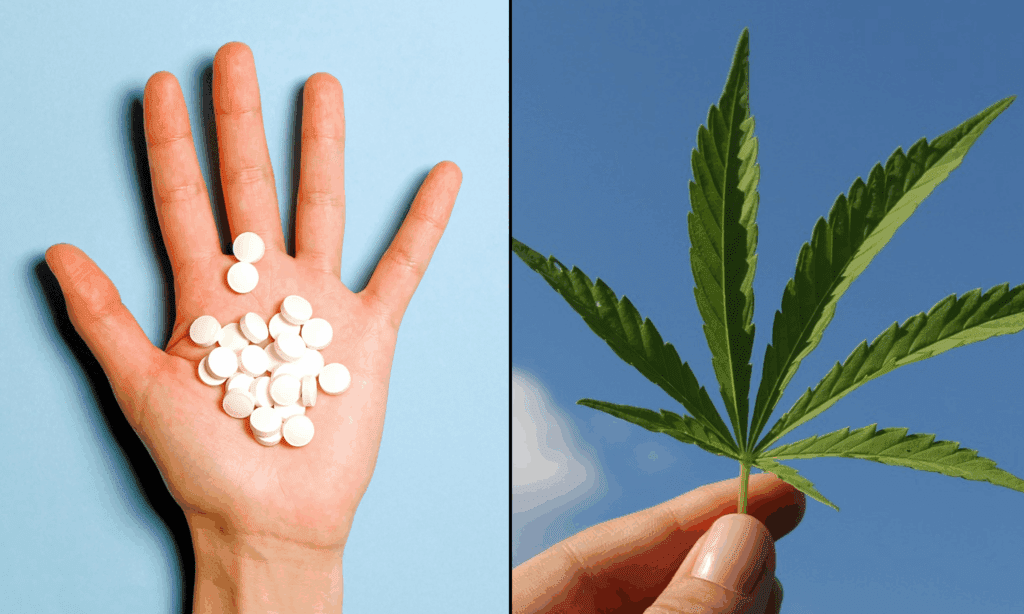This study provides more proof that marijuana is an alternative to opioids for pain relief.
The researchers at Murdoch University in Australia and Perth Pain Management Centre wanted to know how cannabinoids would affect opioid usage among people suffering from chronic pain.
According to the study, which was published Monday in Pain Management, “co-prescriptions of cannabinoids might enable patients reduce their opioid prescription prescribed for chronic pain”
Researchers followed the treatment of two groups of patients for a period of one year to assess their relationship with cannabis and opioids. One cohort consisted of 102 pain patients who had been prescribed opioids but also cannabis. The other group, composed of 53 patients, was only given opioids without marijuana at another clinic.
The median patient took about 40mg of opioids a day at baseline. After one year, those who received the median dosage of 15 mg delta-9-THC and 15 mg CBD in medical cannabis “significantly reduced” their opioid intake to 2.7mg per day. The opioid-only cohort after one year was taking a median 42.3 mg per day.
Study authors noted that the introduction of cannabis can reduce opioid consumption and provide additional benefits to patients with disabilities or insomnia. However, only a minority of patients tolerate this treatment.
The opioid intake of the group that included cannabis in its treatment program decreased “significantly” after 6 and 12 month.
Physical activity and sleep both improved. The study concludes that these findings show medicinal cannabis helps patients reduce opioid intake and improve physical activity and sleeping.
These findings also align with the growing scientific literature that explores the relationship between marijuana and opioid use.
For example, a study published earlier this year in the journal Drug and Alcohol Review found that, among drug users who experience chronic pain, daily cannabis use was linked to a higher likelihood of quitting the use of opioids—especially among men.
A study published late last year also found that legalizing medical cannabis appeared to significantly reduce monetary payments from opioid manufacturers to doctors who specialize in pain, with authors finding “evidence that this decrease is due to medical marijuana becoming available as a substitute” for prescription painkillers.
Another recent study also found a decrease in opioid fatal overdoses when marijuana for adults was legalized. That study found a “consistent negative relationship” between legalization and fatal overdoses, with more significant effects in states that legalized cannabis earlier in the opioid crisis. According to the authors, recreational marijuana legalization is “associated with an approximate 3.5 death reduction per 100,000 persons.”
This report stated that “our findings suggest that broader access to recreational marijuana could help combat the opioid epidemic.” Previous research has shown that marijuana, primarily used for medical purposes, can help reduce the number of opioid prescriptions. We also found it could reduce overdose deaths.
Another recently published report into prescription opioid use in Utah following the state’s legalization of medical marijuana found that the availability of legal cannabis both reduced opioid use by patients with chronic pain and helped drive down prescription overdose deaths statewide. It concluded that the results showed “cannabis plays a significant role in pain management, and the reduction of opioid consumption.”
Yet another study, published in 2023, linked medical marijuana use to lower pain levels and reduced dependence on opioids and other prescription medications. And another, published by the American Medical Association (AMA) last February, found that chronic pain patients who received medical marijuana for longer than a month saw significant reductions in prescribed opioids.
About one in three chronic pain patients reported using cannabis as a treatment option, according to a 2023 AMA-published report. A majority of this group claimed to have used cannabis in place of other pain medicines, including opioids.
Other research published that year found that letting people buy CBD legally significantly reduced opioid prescription rates, leading to 6.6 percent to 8.1 percent fewer opioid prescriptions.
A 2022 research paper that analyzed Medicaid data on prescription drugs, meanwhile, found that legalizing marijuana for adult use was associated with “significant reductions” in the use of prescription drugs for the treatment of multiple conditions.
A 2023 report linked state-level medical marijuana legalization to reduced opioid payouts to doctors—another datapoint suggesting that patients use cannabis as an alternative to prescription drugs when given legal access.
Researchers in another study, published last year, looked at opioid prescription and mortality rates in Oregon, finding that nearby access to retail marijuana moderately reduced opioid prescriptions, though they observed no corresponding drop in opioid-related deaths.
Cannabis may also be an effective alternative for opioids to manage pain, according to other recent studies.
A report published recently in the journal BMJ Open, for instance, compared medical marijuana and opioids for chronic non-cancer pain and found that cannabis “may be similarly effective and result in fewer discontinuations than opioids,” potentially offering comparable relief with a lower likelihood of adverse effects.
Separate research published found that more than half (57 percent) of patients with chronic musculoskeletal pain said cannabis was more effective than other analgesic medications, while 40 percent reported reducing their use of other painkillers since they began using marijuana.




